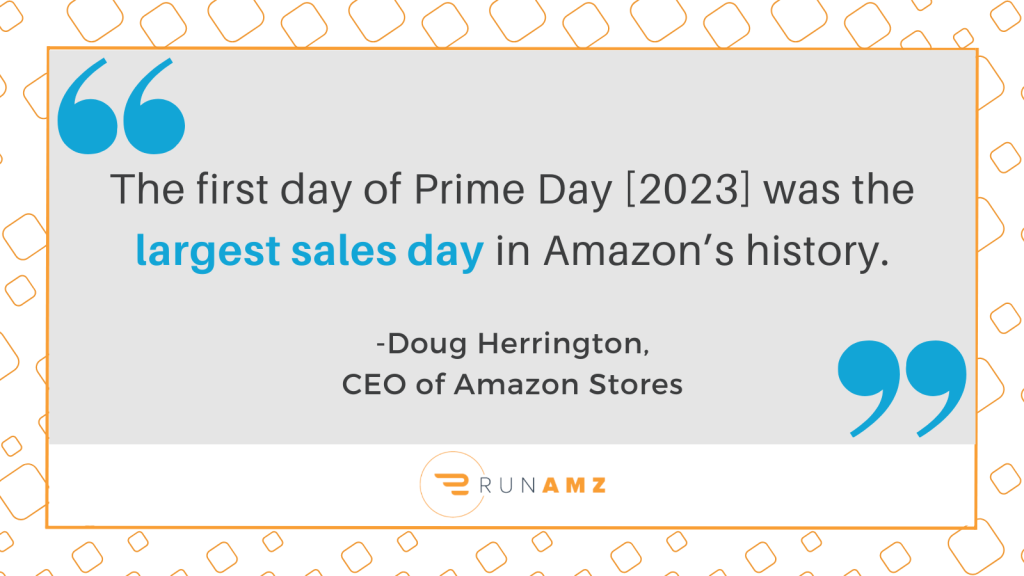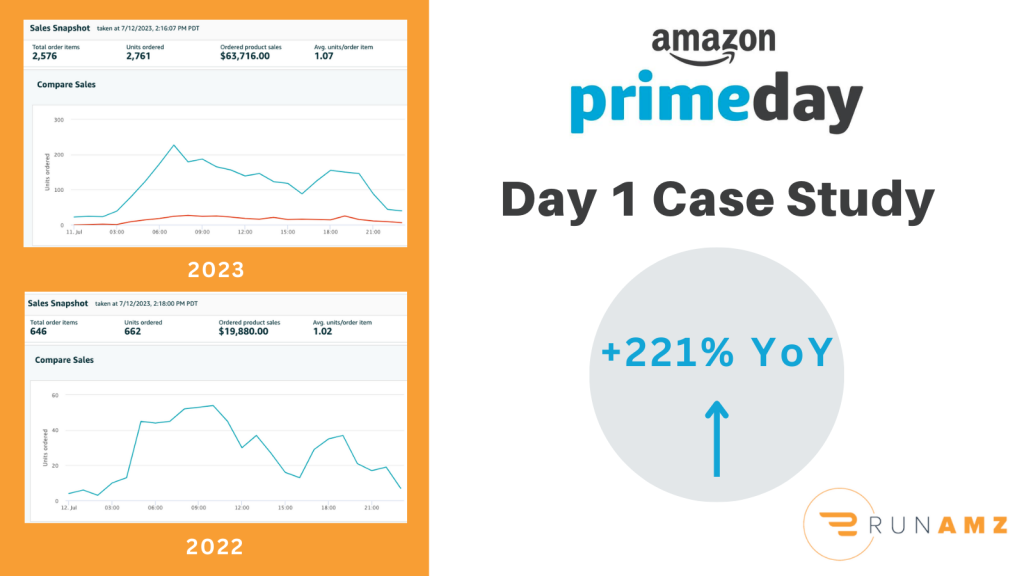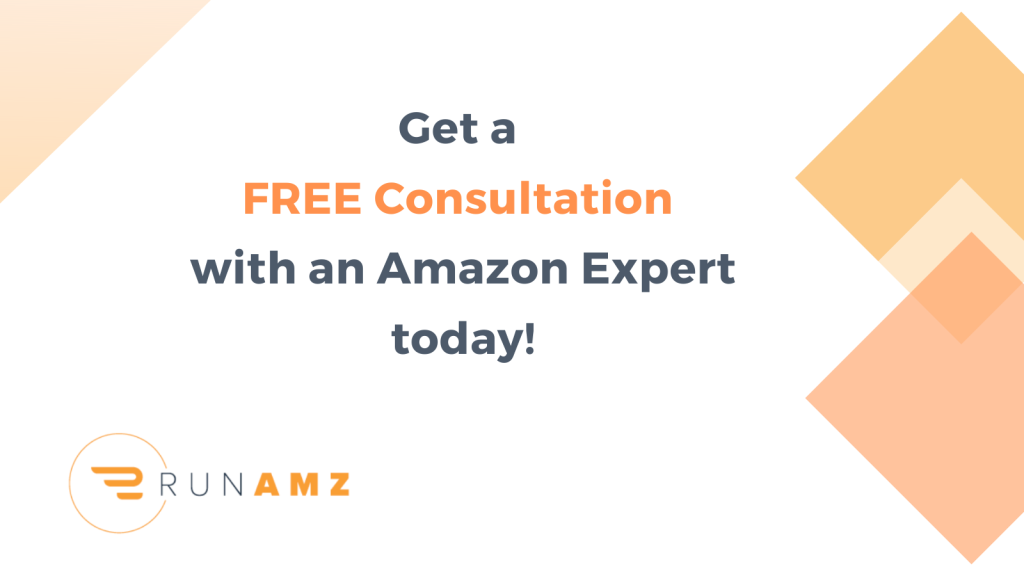Amazon’s annual Prime Week has famously brought consumers online in masses since the retail giant announced the shopping event back in 2015. The two-day savings special generates buzz amongst ecommerce brands months in advance, ensuring companies take advantage of the boost in traffic on Amazon during the week.
Traditionally, Prime Week was meant to promote the exclusivity of Prime member features, such as fast shipping and delivery times. However, in more recent years, Amazon has leveraged Prime Day to generate new membership interest amongst non-Prime members, hoping for a drastic increase in sign-ups before and during the week of sales.
Below, we’ll explore trends the Run AMZ team of Amazon experts noticed during this last Prime Day, and takeaways brands can use for Amazon’s next week of discounts coming in October 2023.
Trends from Amazon Prime Days 2023

This year, Amazon’s Prime Week was more successful than ever before. “The first day of Prime Day was the largest sales day in Amazon’s history,” said Doug Herrington, CEO of Amazon Stores. Over the 48-hours of Prime Day, more than 200 million Prime members across 25 countries shopped Amazon deals (source). Thanks to this immense traffic, Amazon sold over 375 million products, a 75 million increase from 2022. These purchases equated to $12.7 billion (about $39 per person in the US), a 6.1% increase from last year (source). Not only were more shoppers actively buying on Amazon this Prime Day compared to previous years, but brands utilizing Prime Day deals saw an impressive uptick in sales.
2023 Prime Day shoppers also logged onto Amazon earlier in the day to get ahead on sales. The afternoon was the peak time for consumers according to the level of traffic on the Amazon site.
Run AMZ also noticed Amazon was using personalization to present shoppers with a more relevant shopping experience based on their browsing and purchase history. Knowing Amazon is shifting more towards personalization reinforces the importance of retargeting marketing campaigns and leveraging existing data and analytics. Brands already have access to customer information and trends – Amazon is simply leveraging them to improve the shopping experience. As an Amazon seller, it’s key to also leverage this data by continuing to better understand your customers, provide them with the content they need to convert, and continually improve the buying experience on your listings and storefront.
Lastly, with advertising specifically, the Run AMZ marketing team noticed that CPC (cost-per-click) varied throughout the day, especially given specific product categories. At one point, the CPC for the Electronics category surpassed $7.00! Outside of Prime Day, we usually see CPCs around $2.00. Although this high price makes sense given the amount of traffic on Amazon throughout Prime Day, it’s crucial for brands to keep an eye on budget when CPC is that drastic. During Prime Week budgets need to be checked almost hourly given the unpredictable nature of Amazon Ads during the week of sales.
Prime Deals and Discounts for Brands
Leading up to Prime Day, sellers have the option to determine which of their products will have discounts and what type of discounts are being used. The two types of discounts we’ll discuss are Coupons and Prime Exclusive Deals.
Are Prime Member Coupons an Outdated Strategy?
If you’re a regular Prime shopper, you may have seen Coupon badges on products throughout the year. Although coupons are typically a great strategy for brands to increase impressions, click-through-rates, and conversions – Prime Day may be an exception.

Back in 2022, the Run AMZ team noticed Amazon was pushing Prime Exclusive Deals over Prime Member Coupons. Although Prime members have access to both discounts, Amazon knew that most shoppers on the site for Prime Day specifically were looking for once-in-a-year deals that they wouldn’t be able to redeem at any other time. By promoting products to shoppers with a Prime Exclusive Deal badge, as opposed to just a Coupon badge, Amazon knew they were pushing a sense of urgency upon shoppers – thus resulting in more conversions on the Prime Exclusive Deal products.
Prime Exclusive Deals Make Waves
Due to the trend our team noticed last year, Run AMZ knew the discount to prioritize for our valued brand partners had to be Prime Exclusive Deals to maximize sales during Prime Week. For brands on Seller Central, we shifted the focus away from Coupons and instead implemented Prime Exclusive Deals across their catalogs.
Case Study
Sunscreen Brand has a 221% Year-over-year Increase in Sales on Prime Day
A sunscreen brand in the competitive Beauty & Personal Care category on Amazon wanted to boost sales by taking advantage of Prime Day. To prepare, Run AMZ began optimizing the brand’s most popular ASIN listings up to 4 months ahead of Prime Day to ensure everything would be set up properly in time. It’s crucial to ramp up content and marketing efforts before Prime Week to avoid any mishaps come the big day.
In addition, the brand’s Client Success Manager initiated early conversations between the advertising and logistics departments. Aligning the ad strategy with inventory is another key step to guarantee that high-value products, especially those that ads are sending traffic to, have enough inventory in stock to handle the increase in shoppers that Prime Day is known for.
Run AMZ also utilized Amazon’s Demand Side Platform (DSP) prior to and during Prime Week to increase top-of-funnel awareness amongst potential customers off Amazon. Using a DSP strategy can help you reach new, relevant audiences that may not already be aware of your products on Amazon. For the sunscreen brand Run AMZ was working with, we took advantage of DSP to drive product interest back into the Amazon ecosystem, boosting their Amazon sales as a result.
Overall, Run AMZ’s powerful combination of pre-advertising strategy to win Top of Search Placement the weeks leading into Prime, combined with strong promotional strategy of Prime Exclusive Discounts on the brand’s top ASINs, resulted in a 221% year-over-year increase in sales!
See below for comparison of sales from 1st day of Prime 2022 versus 1st day of Prime 2023.

Interested in similar results for your brand? Meet with one of our experts today: http://runamz.com/contact
When to use Prime Exclusive Deals versus Prime Member Coupons
Now that we’ve established how valuable Prime Exclusive Deals can be, how would you go about determining eligibility as opposed to Prime Member Coupons? For starters, both discounts require at least a 20% off price reduction. Ideally, your products would have a greater than 20% profit margin in order to take advantage of these discounts while still maintaining profit, but if you happen to have a low profit margin or are worried about being able to afford running a discount this big, then we’d actually urge you to focus on regular coupons (say, a 5% discount) instead of losing out on profit just to get a Prime Day badge on your product.
Assuming you have at least one product with an equal to or greater than 20% profit margin, you’re on the right track to be eligible for either Prime Exclusive Deals or Prime Member Coupons. To determine which would guarantee the most conversions, you’ll also have to consider ratings and reviews. You must have at least a 4-star Seller Rating (or no rating) to be eligible for both discounts. However, Prime Exclusive Deals require at minimum a 3.5-star review rating (or no rating), whereas Prime Member Coupons only require a minimum of 2.5-star review ratings. Therefore, we recommend a Prime Member Coupon strategy if your product has less-than-ideal review ratings. These coupons are also displayed on the Prime Member Coupons page throughout Prime Day which could lead to additional product impressions and click-through-rates (source). Because of this, Prime Member Coupons are still a great alternative to nothing – although, we still urge you to utilize Prime Exclusive Deals if eligible.
Planning for Amazon Prime Day 2
If your brand didn’t see an increase in Prime Day sales this year, don’t worry – there’s another Prime Week coming up again this Fall. Amazon Day October 2022 took place on 10/11 and 10/12. We can expect this year’s second Prime Day to commence around the same dates.
Begin Preparing for the Amazon October Sale Now
Amazon has already announced that Fall Prime Day Lightning Deal submissions must be submitted by August 11, 2023. We expect Amazon will announce their Fall Prime dates in mid to late September. Once they do, you may see a dip in shoppers in the weeks leading up to the sale. Don’t worry – now is the best time for you to focus on optimizing your detail pages, building out your storefront, increasing and improving reviews, and aligning your various departments (logistics, advertising, creative) in preparation.
Best Practices for Amazon Prime Day success:
- Invest in Prime Exclusive Deals if you’re able to.
- Launch Prime Day deals the week before to get a head start on generating pageviews (this also gives you time to troubleshoot prior to the event launch).
- Monitor cost-per-click throughout the day.
- Run deals ~2 days post-Prime Day to maintain high conversion rates.
Don’t let your brand get left in the dust next Prime Day. Reach out to chat with one of our Amazon experts today: http://runamz.com/contact

